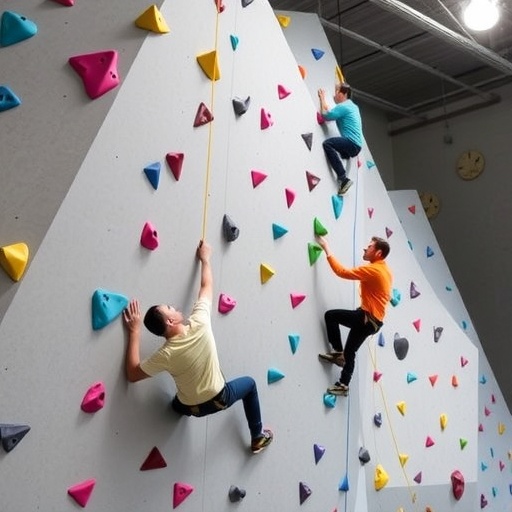A groundbreaking systematic review published in BMC Psychiatry sheds new light on the therapeutic potential of indoor rock climbing and bouldering as innovative treatments for depression. As one of the most common and debilitating mental health disorders globally, depression has historically been managed through psychotherapy, cognitive behavioural therapy, and pharmacological means such as antidepressants. However, emerging evidence positions exercise therapy, particularly rock climbing, as a promising adjunctive intervention due to its unique psychological and physical benefits.
Rock climbing integrates intense physical activity with cognitive and motor skills, demanding a high level of focus and mindfulness. This combination distinguishes it from traditional forms of exercise, suggesting that it may engage mental health processes differently. The review, spearheaded by Larsson, Larsson, and Nordeman, systematically examined controlled trials assessing the efficacy of indoor rock climbing against various comparators in adults diagnosed with moderate depression. Their work aimed not only to quantify symptom reduction but also to evaluate the clinical relevance and longevity of treatment effects.
The researchers conducted a comprehensive literature search across major databases including PubMed, Scopus, and Web of Science, covering all publications up to January 2025 without language or time constraints. Utilizing robust methodological frameworks like the PICO model and adhering to PRISMA reporting standards, the team ensured a methodical and unbiased synthesis of available data. Seven studies, encapsulated within ten research articles and involving 471 participants, met the stringent inclusion criteria, highlighting recent research contributions primarily from the German and Austrian scientific communities.
Methodological quality was carefully assessed using the PEDro scale, with results indicating generally good study design standards (median score of 6 out of 10). This lends credibility to the overall findings despite inherent heterogeneity in climbing modalities and study comparators. A particularly noteworthy discovery was that indoor bouldering combined with mindfulness exercises elicited significant reductions in depressive symptoms. For example, one study reported an 8.3-point improvement on the Montgomery-Åsberg Depression Rating Scale (MADRS), surpassing the minimal clinically important difference (MCID) threshold of 5 points. This indicates a meaningful alleviation of symptoms, rather than a mere statistical artifact.
The temporal dynamics of symptom relief were also explored in depth. While shorter-term interventions yielded some benefits, sustained effects at 6 to 12 months were predominantly observed following longer durations of climbing therapy, specifically interventions spanning 8 to 10 weeks. This finding underscores the necessity of ongoing engagement with the activity to maintain mental health gains and suggests that rock climbing could be strategically incorporated into long-term depression management plans.
Less conclusive but still promising evidence emerged for top-rope climbing over a four-week period, which also decreased depressive symptoms. However, its effects did not meet the MCID, and certainty of evidence was rated low, highlighting the need for further rigorous trials examining different climbing disciplines independently. Encouragingly, none of the included studies reported adverse events, attesting to the safety and tolerability of climbing interventions even among individuals coping with depression.
The neuropsychological mechanisms through which climbing exerts its effects are subject to ongoing investigation. Hypotheses focus on the activity’s demand for concentrated problem-solving, real-time risk assessment, and bodily awareness, all of which are closely tied to mindfulness processes known for their antidepressant properties. Moreover, the physical exertion inherent in climbing stimulates neurobiological pathways related to neurogenesis and neurotransmitter modulation, which may synergize with psychological benefits to reduce depressive symptoms.
Despite these advances, the authors underscore critical gaps requiring attention in future research. Chief among these is the challenge of disentangling the specific contribution of climbing from co-interventions like mindfulness exercises. Multifaceted intervention designs complicate attribution of effects exclusively to climbing. Additionally, direct comparisons with established treatments such as selective serotonin reuptake inhibitors (SSRIs) or aerobic exercise modalities remain largely unexplored, limiting generalizability and clinical decision-making guidance.
This review heralds a paradigm shift in mental health therapeutics, promoting physical engagement paired with cognitive mindfulness as a holistic treatment modality. The appeal of indoor rock climbing extends beyond clinical effectiveness, potentially enhancing patient motivation, social connectedness, and self-efficacy. These psychosocial dimensions can substantially influence recovery trajectories and quality of life, positioning climbing as a multifaceted adjunct to conventional depression therapies.
Clinicians and mental health practitioners may consider incorporating climbing interventions into individualized treatment plans, particularly for patients seeking non-pharmacological options or complementing ongoing therapies. Facilities and health systems should also recognize the growing evidence base to support investment in accessible climbing programs tailored to mental health needs. Community-level implementation could foster greater inclusivity and long-term wellness benefits across populations.
To maximize therapeutic impact, future studies must refine intervention protocols, optimize session frequency and intensity, and elucidate underlying psychological and physiological pathways. Large-scale randomized controlled trials with diverse populations and standardized outcome measures are vital to confirm the reproducibility and scalability of findings presented in this pioneering review.
In sum, indoor rock climbing and bouldering emerge as effective, safe, and sustainable treatments for adults with moderate depression, with bouldering combined with mindfulness exercises demonstrating particularly strong clinical utility. This evidence augments the expanding landscape of exercise-based mental health interventions and ignites compelling avenues for multidisciplinary research and practice innovations aimed at alleviating depressive morbidity worldwide.
Subject of Research: Effectiveness of indoor rock climbing and bouldering as treatments for moderate depression
Article Title: Effectiveness of indoor rock climbing and bouldering as treatment for depression – a systematic review
Article References:
Larsson, R., Larsson, A. & Nordeman, L. Effectiveness of indoor rock climbing and bouldering as treatment for depression – a systematic review. BMC Psychiatry 25, 858 (2025). https://doi.org/10.1186/s12888-025-07292-3
Image Credits: AI Generated




